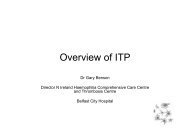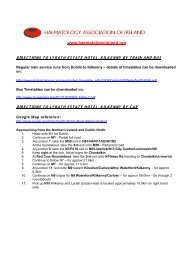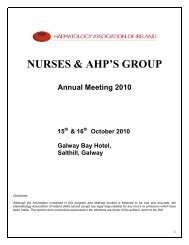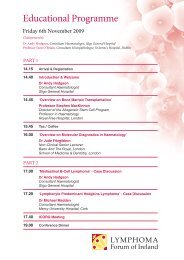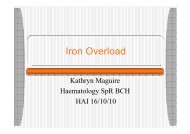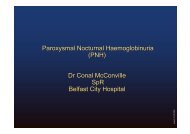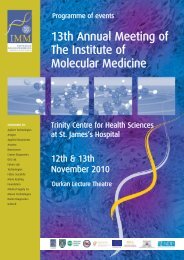Guidelines on Diagnosis and Treatment of Malignant Lymphomas
Guidelines on Diagnosis and Treatment of Malignant Lymphomas
Guidelines on Diagnosis and Treatment of Malignant Lymphomas
Create successful ePaper yourself
Turn your PDF publications into a flip-book with our unique Google optimized e-Paper software.
<strong>of</strong> cases <strong>and</strong> EBV in about 50%, but no associati<strong>on</strong> with<br />
KSHV/HHV8 has been found. Markers <strong>of</strong> plasmacytic<br />
differentiati<strong>on</strong> such as CD138 are positive.<br />
Staging<br />
Staging <strong>of</strong> HIV-related lymphomas uses the classificati<strong>on</strong> used in<br />
other settings such as the Ann Arbor classificati<strong>on</strong> <strong>and</strong> that used<br />
for BL.<br />
Recommended Investigati<strong>on</strong>s:<br />
Generic: see page 2<br />
Specific:<br />
Full history <strong>and</strong> examinati<strong>on</strong> with particular<br />
reference to AIDS status <strong>and</strong> HAART therapy<br />
CD4 count<br />
Potential Pitfalls<br />
a. Failure to recognise HIV-positive status<br />
b. Inappropriate nihilism in face <strong>of</strong> better treatment outcomes<br />
c. Failure to c<strong>on</strong>sider drug interacti<strong>on</strong>s in the c<strong>on</strong>text <strong>of</strong> HAART<br />
d. Failure to use appropriate prophylaxis against<br />
opportunistic infecti<strong>on</strong>s<br />
<strong>Treatment</strong><br />
Patients need to be managed in a multidisciplinary setting with<br />
joint management by an infectious disease team <strong>and</strong> a team<br />
skilled in the management <strong>of</strong> lymphoma.<br />
Comorbidities <strong>and</strong> the status <strong>of</strong> HIV will determine the intensity<br />
<strong>of</strong> treatment possible.<br />
HL <strong>and</strong> BL are treated using st<strong>and</strong>ard therapy <strong>and</strong> c<strong>on</strong>tinuing<br />
HAART. The outcome <strong>of</strong> patients with DLBCL treated with<br />
dose adjusted R-EPOCH appears particularly encouraging.<br />
Favourable prognostic factors include good performance status,<br />
low IPI, preserved CD4 count <strong>and</strong> no history <strong>of</strong> IV drug abuse.<br />
Patients with BL are usually treated with st<strong>and</strong>ard Burkitt<br />
regimens, though good results have also been obtained with<br />
DA-R-EPOCH <strong>and</strong> both DFS <strong>and</strong> OS at 5 years<br />
<strong>of</strong> about 50% can be achieved.<br />
PEL <strong>and</strong> primary CNS lymphoma remain almost uniformly fatal<br />
with a median survival <strong>of</strong> 6 m<strong>on</strong>ths.<br />
Relapse Evaluati<strong>on</strong> <strong>and</strong> Follow Up<br />
Resp<strong>on</strong>se evaluati<strong>on</strong> <strong>and</strong> follow up should be the same as for<br />
immune competent patients. Patients with HIV-related lymphomas<br />
will also be <strong>on</strong> lifetime follow up by the infectious disease service.<br />
64



